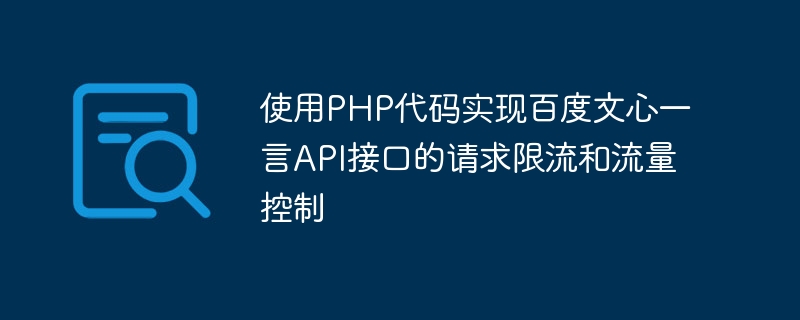Home >Backend Development >PHP Tutorial >Use PHP code to implement request current limiting and flow control of Baidu Wenxinyiyan API interface
Use PHP code to implement request current limiting and flow control of Baidu Wenxinyiyan API interface
- PHPzOriginal
- 2023-08-25 15:42:311738browse

Use PHP code to implement request limit and flow control of Baidu Wenxin Yiyan API interface
During the development process, we often need to use third-party APIs to obtain data. However, when using these APIs, we may encounter problems with request throttling and flow control. This requires us to reasonably control the request frequency to avoid exceeding the API provider's limits and protect our own applications.
In this article, I will use PHP to show how to implement request limit and flow control on Baidu Wenxin Yiyan API interface.
First, we need to obtain the interface address and provided key of Baidu Wenxin Yiyan API. Then we can use the following code to implement request current limiting and flow control.
<?php
// 定义API接口地址和密钥
$apiUrl = 'https://v1.hitokoto.cn';
$apiKey = 'your_api_key';
// 定义请求间隔时间和请求次数限制
$requestInterval = 1; // 每次请求间隔1秒
$requestLimit = 10; // 每分钟最多请求10次
// 记录上次请求的时间和请求次数
$lastRequestTime = 0;
$requestCount = 0;
// 模拟发送请求的函数
function sendRequest($apiUrl, $apiKey)
{
// 模拟发送请求,并返回API响应
// 这里可以使用curl或file_get_contents等函数来发送请求
// 以curl为例:
$curl = curl_init();
curl_setopt($curl, CURLOPT_URL, $apiUrl);
curl_setopt($curl, CURLOPT_RETURNTRANSFER, 1);
$response = curl_exec($curl);
curl_close($curl);
// 返回API响应结果
return $response;
}
// 判断是否可以发送请求
function canSendRequest($requestInterval, $requestLimit, &$lastRequestTime, &$requestCount)
{
// 获取当前时间
$currentTime = time();
// 判断是否超过请求限制
if ($requestCount >= $requestLimit && $currentTime - $lastRequestTime < 60) {
return false;
}
// 判断是否超过请求间隔时间
if ($currentTime - $lastRequestTime < $requestInterval) {
return false;
}
// 更新上次请求时间和请求次数
$lastRequestTime = $currentTime;
$requestCount++;
return true;
}
// 发送API请求
if (canSendRequest($requestInterval, $requestLimit, $lastRequestTime, $requestCount)) {
// 发送请求
$response = sendRequest($apiUrl, $apiKey);
// 处理API响应
// 这里可以根据API返回的数据进行相应的处理
echo $response;
} else {
// 请求限流,返回错误提示
echo 'Exceeded the request limit, please try again later.';
}
?>In the above sample code, we first defined the API interface address and key. Then, we define the request interval and the request number limit. Next, we use two variables to record the time of the last request and the number of requests.
Before sending an API request, we use the canSendRequest function to determine whether the request can be sent. If the request limit or request interval time is exceeded, false is returned, otherwise true is returned. If the request can be sent, call the sendRequest function to send the request and get the API response. Finally, we can perform corresponding processing based on the data returned by the API.
It should be noted that the above is just a simple example, we can modify the code according to our actual needs. In addition, in order to protect the security of API keys, it is recommended to store the keys in a safe place, such as a configuration file or environment variable, rather than writing them directly in the code.
To summarize, by reasonably controlling the request frequency and traffic, we can effectively avoid exceeding the API provider's limits and protect our own applications. I hope this article can help you understand and implement request limit and flow control on Baidu Wenxinyiyan API interface.
The above is the detailed content of Use PHP code to implement request current limiting and flow control of Baidu Wenxinyiyan API interface. For more information, please follow other related articles on the PHP Chinese website!

